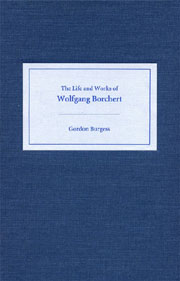Book contents
- Frontmatter
- Contents
- Acknowledgments
- List of Abbreviations
- Introduction
- 1 Childhood, School, Apprenticeship: 1921–1940
- 2 “The Happiest Time of My Life': January–June 1941
- 3 The Eastern Front and Courts-Martial: 1941–1943
- 4 Actor Turned Writer: Jena, Hamburg, and Basel: 1944–1947
- 5 The Poems
- 6 Draussen vor der Tür
- 7 The Short Stories
- 8 The Reception of Borchert's Life and Works
- Conclusion
- Published Works Cited
- Index
7 - The Short Stories
Published online by Cambridge University Press: 05 February 2013
- Frontmatter
- Contents
- Acknowledgments
- List of Abbreviations
- Introduction
- 1 Childhood, School, Apprenticeship: 1921–1940
- 2 “The Happiest Time of My Life': January–June 1941
- 3 The Eastern Front and Courts-Martial: 1941–1943
- 4 Actor Turned Writer: Jena, Hamburg, and Basel: 1944–1947
- 5 The Poems
- 6 Draussen vor der Tür
- 7 The Short Stories
- 8 The Reception of Borchert's Life and Works
- Conclusion
- Published Works Cited
- Index
Summary
The Postwar German “Story”
BEFORE WOLFGANG BORCHERT, the conventional short prose form in German was the novella, which flourished during the nineteenth and first half of the twentieth centuries. Goethe famously described the novella as focusing on an unusual event that could have happened. The length could be anything from a few pages to over a hundred, and at some point, the action would take an unexpected or decisive turn of events, called appropriately the Wendepunkt in German. Conventionally, there would be an omniscient narrator, and the central tale would often be set within a framework narrative (Rahmenerzählung). The novella was a “closed” form, in that by the end the central tale would have been completed, the fates of the central figures would have been sealed, and no further reflection by the reader on what happened next would be necessary.
But those who began writing prose literature in the years immediately after the Nazi tyranny considered the novella to be a form that had been developed by German writers, and they regarded it as outdated and suspect. The form of the Anglo-American short story, on the other hand, was fresh and untainted, as was the term “story” itself. In an article in the Hamburg periodical Nordwestdeutsche Hefte, entitled “Die amerikanische Story,” Ernst Schnabel claimed in 1946: “Die Story ist eine ganz bestimmte Art von Geschichte […] Ihre Zeit ist aber erst in unseren Tagen angebrochen. Die Story ist etwas anderes als die Novelle, sie löst — wenn nicht alles täuscht — die Novelle ab.”
- Type
- Chapter
- Information
- The Life and Works of Wolfgang Borchert , pp. 174 - 218Publisher: Boydell & BrewerPrint publication year: 2003

